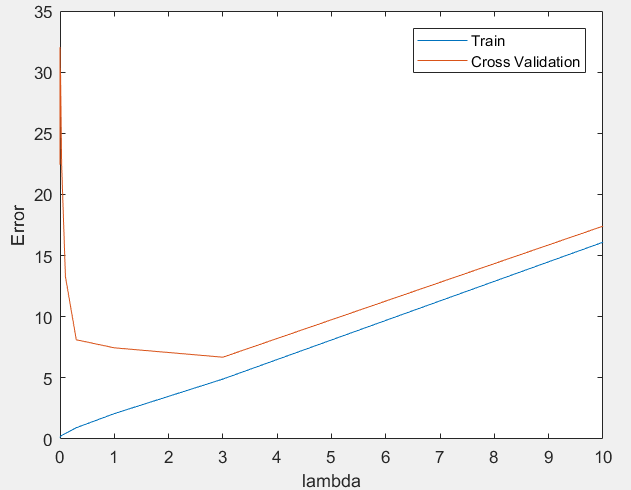题目下载【传送门】
第1步:读取数据文件,并可视化:
% Load from ex5data1:
% You will have X, y, Xval, yval, Xtest, ytest in your environment
load ('ex5data1.mat');
% m = Number of examples
m = size(X, 1);
% Plot training data
plot(X, y, 'rx', 'MarkerSize', 10, 'LineWidth', 1.5);
xlabel('Change in water level (x)');
ylabel('Water flowing out of the dam (y)');
运行结果:
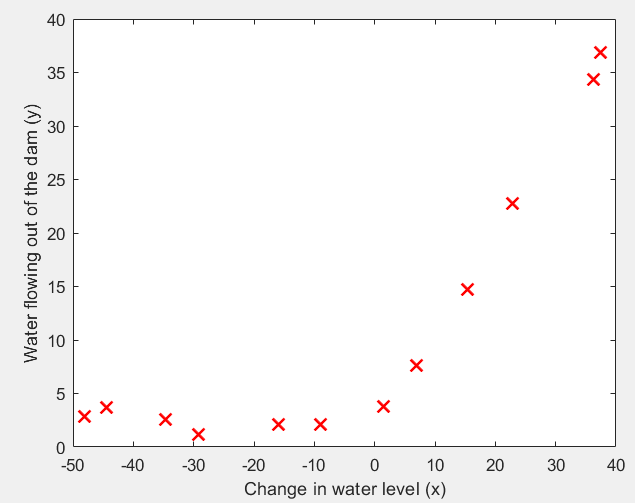
第2步:实现linearRegCostFunction函数,采用线性回归和正规化求 J 和 grad:
function [J, grad] = linearRegCostFunction(X, y, theta, lambda) % Initialize some useful values m = length(y); % number of training examples % You need to return the following variables correctly J = 0; grad = zeros(size(theta)); theta_copy = theta; theta_copy(1, :) = 0 J = 1 / (2 * m) * sum((X * theta - y) .^ 2) + lambda / (2 * m) * sum(theta_copy .^ 2); grad = 1 / m * (X' * (X * theta - y)) + lambda / m * theta_copy; grad = grad(:); end
第3步:实现训练函数trainLinearReg:
function [theta] = trainLinearReg(X, y, lambda)
% Initialize Theta
initial_theta = zeros(size(X, 2), 1);
% Create "short hand" for the cost function to be minimized
costFunction = @(t) linearRegCostFunction(X, y, t, lambda);
% Now, costFunction is a function that takes in only one argument
options = optimset('MaxIter', 200, 'GradObj', 'on');
% Minimize using fmincg
theta = fmincg(costFunction, initial_theta, options);
end
使用 lambda = 0,测试结果:
% Train linear regression with lambda = 0
lambda = 0;
[theta] = trainLinearReg([ones(m, 1) X], y, lambda);
% Plot fit over the data
plot(X, y, 'rx', 'MarkerSize', 10, 'LineWidth', 1.5);
xlabel('Change in water level (x)');
ylabel('Water flowing out of the dam (y)');
hold on;
plot(X, [ones(m, 1) X]*theta, '--', 'LineWidth', 2)
hold off;
运行结果:很显然,采用 y = θ0 + θ1x 欠拟合。

第4步:绘制关于训练集数量的学习曲线,在lambda = 0 的情况下,观察训练集的大小1 ~ m给训练误差和验证误差的影响:
lambda = 0;
[error_train, error_val] = ...
learningCurve([ones(m, 1) X], y, ...
[ones(size(Xval, 1), 1) Xval], yval, ...
lambda);
plot(1:m, error_train, 1:m, error_val);
title('Learning curve for linear regression')
legend('Train', 'Cross Validation')
xlabel('Number of training examples')
ylabel('Error')
axis([0 13 0 150])
其中学习曲线函数learningCurve:
function [error_train, error_val] = ...
learningCurve(X, y, Xval, yval, lambda)
for i = 1:m,
X_temp = X(1:i, :);
y_temp = y(1:i);
theta = trainLinearReg(X_temp, y_temp, lambda);
error_train(i) = 1 / (2 * i) * sum((X_temp * theta - y_temp) .^ 2);
error_val(i) = 1 / (2 * m) * sum((Xval * theta - yval) .^ 2);
end
end
运行结果:随着训练集的扩大,训练误差和验证误差均比较大,是高误差问题(欠拟合)。
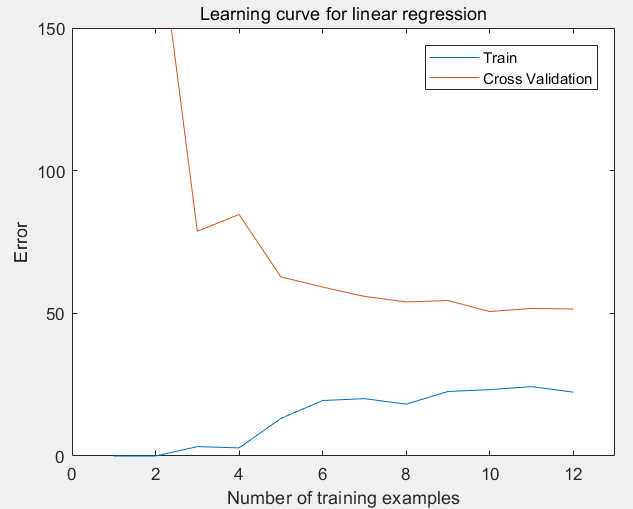
第5步:为了解决欠拟合问题,需要改进特征,下面对训练、交叉验证、测试三组数据进行特征扩充和均值归一化:

p = 8;
% Map X onto Polynomial Features and Normalize
X_poly = polyFeatures(X, p);
[X_poly, mu, sigma] = featureNormalize(X_poly); % Normalize
X_poly = [ones(m, 1), X_poly]; % Add Ones
% Map X_poly_test and normalize (using mu and sigma)
X_poly_test = polyFeatures(Xtest, p);
X_poly_test = bsxfun(@minus, X_poly_test, mu);
X_poly_test = bsxfun(@rdivide, X_poly_test, sigma);
X_poly_test = [ones(size(X_poly_test, 1), 1), X_poly_test]; % Add Ones
% Map X_poly_val and normalize (using mu and sigma)
X_poly_val = polyFeatures(Xval, p);
X_poly_val = bsxfun(@minus, X_poly_val, mu);
X_poly_val = bsxfun(@rdivide, X_poly_val, sigma);
X_poly_val = [ones(size(X_poly_val, 1), 1), X_poly_val]; % Add Ones
fprintf('Normalized Training Example 1:
');
fprintf(' %f
', X_poly(1, :));
其中ployFeatures函数实现特征值扩充的作用:
function [X_poly] = polyFeatures(X, p)
% You need to return the following variables correctly.
X_poly = zeros(numel(X), p);
X_poly(:, 1) = X(:, 1);
for i = 2:p,
X_poly(:, i) = X_poly(:, i-1) .* X(:, 1);
end
end
其中featureNormalize函数实现均值归一化功能:
function [X_norm, mu, sigma] = featureNormalize(X) mu = mean(X); X_norm = bsxfun(@minus, X, mu); sigma = std(X_norm); X_norm = bsxfun(@rdivide, X_norm, sigma); end
第6步:设置不同的lambda,查看拟合结果和学习曲线:
lambda = 0;
[theta] = trainLinearReg(X_poly, y, lambda);
% Plot training data and fit
figure(1);
plot(X, y, 'rx', 'MarkerSize', 10, 'LineWidth', 1.5);
plotFit(min(X), max(X), mu, sigma, theta, p);
xlabel('Change in water level (x)');
ylabel('Water flowing out of the dam (y)');
title (sprintf('Polynomial Regression Fit (lambda = %f)', lambda));
figure(2);
[error_train, error_val] = ...
learningCurve(X_poly, y, X_poly_val, yval, lambda);
plot(1:m, error_train, 1:m, error_val);
title(sprintf('Polynomial Regression Learning Curve (lambda = %f)', lambda));
xlabel('Number of training examples')
ylabel('Error')
axis([0 13 0 100])
legend('Train', 'Cross Validation')
(1)lambda = 0的情况:过拟合
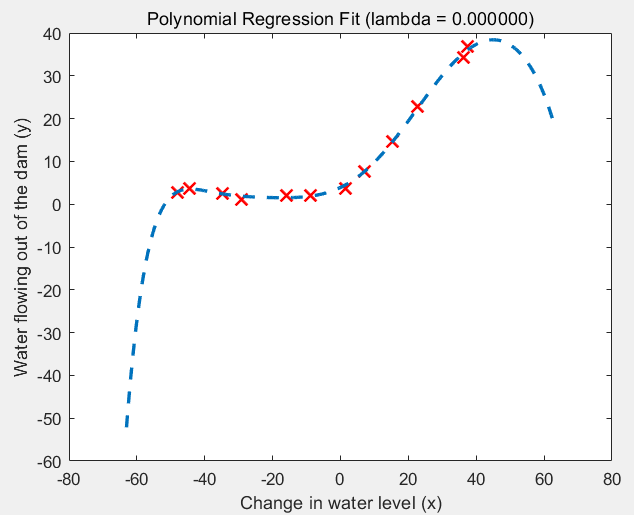
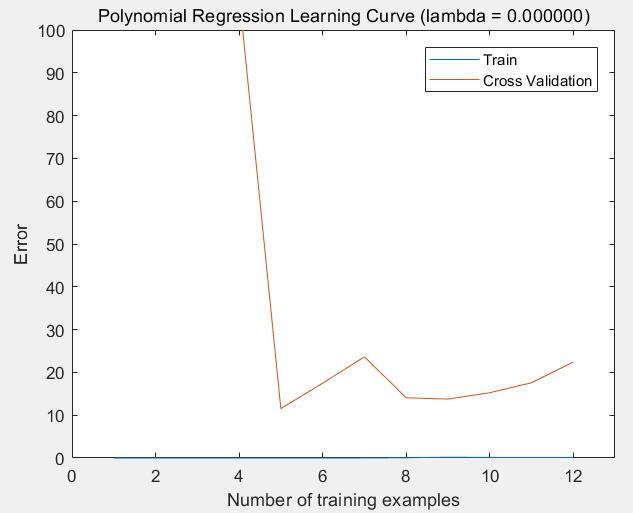
(2)lambda = 1的情况:过拟合
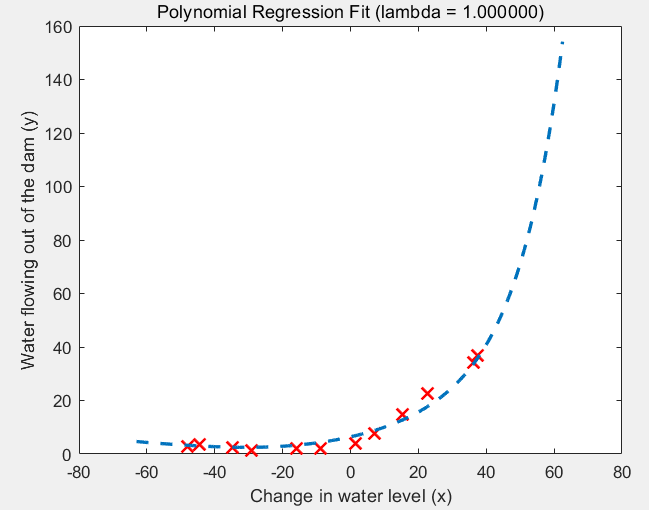
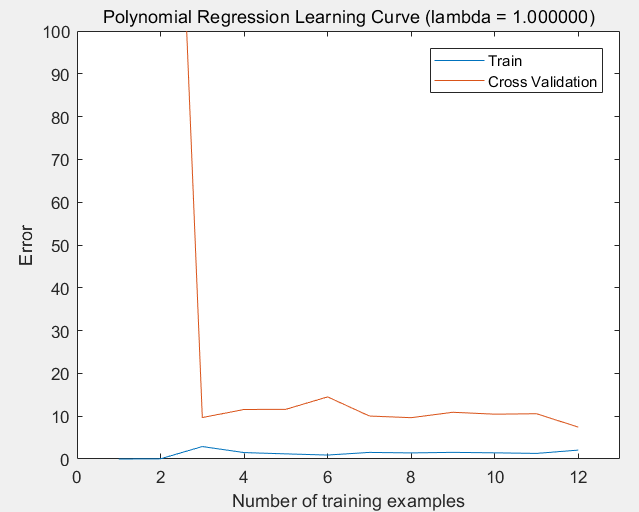
(3)lambda = 100的情况:欠拟合
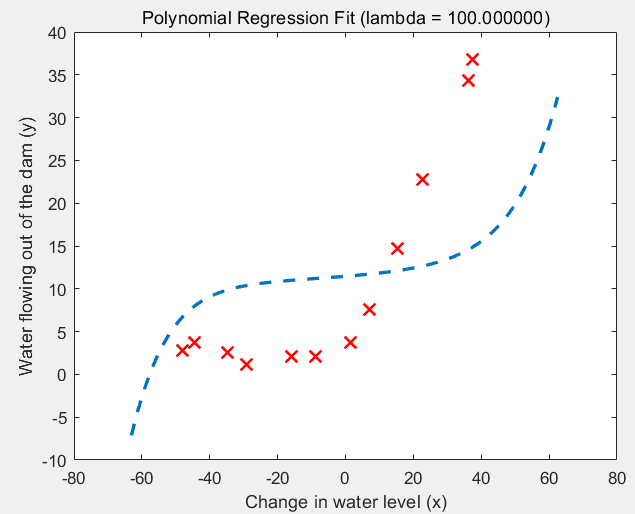

第7步:绘制关于lambda的学习曲线,选择最优的lambda:
[lambda_vec, error_train, error_val] = ...
validationCurve(X_poly, y, X_poly_val, yval);
close all;
plot(lambda_vec, error_train, lambda_vec, error_val);
legend('Train', 'Cross Validation');
xlabel('lambda');
ylabel('Error');
其中validationCurve函数:
function [lambda_vec, error_train, error_val] = ...
validationCurve(X, y, Xval, yval)
m = size(X, 1)
for i = 1:size(lambda_vec),
lambda = lambda_vec(i);
theta = trainLinearReg(X, y, lambda);
error_train(i) = 1 / (2 * m) * sum((X * theta - y) .^ 2);
error_val(i) = 1 / (2 * m) * sum((Xval * theta - yval) .^ 2);
end
end
运行结果:可以看出,在lambda在[2, 3]上有较好的效果。
